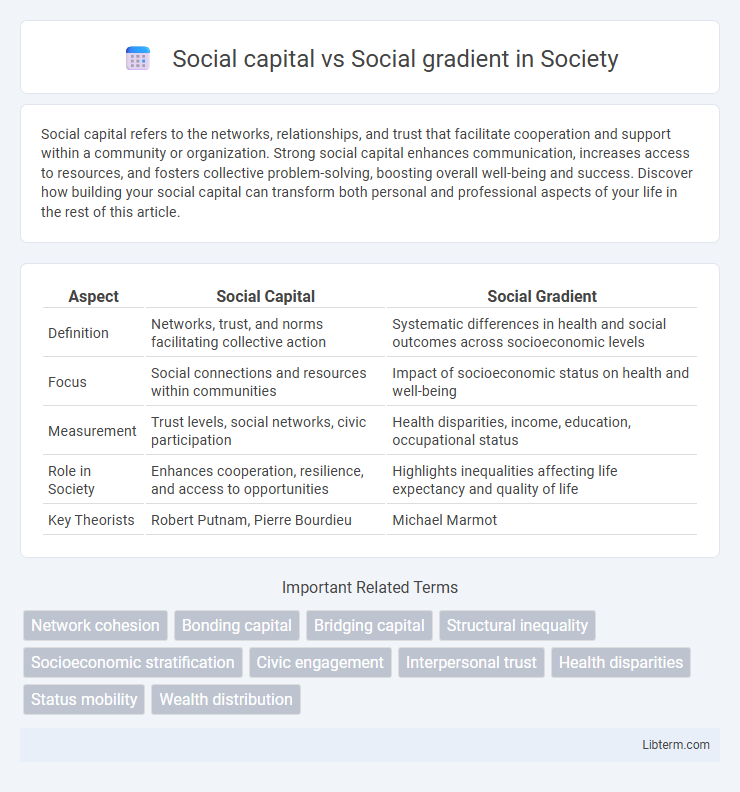Social capital refers to the networks, relationships, and trust that facilitate cooperation and support within a community or organization. Strong social capital enhances communication, increases access to resources, and fosters collective problem-solving, boosting overall well-being and success. Discover how building your social capital can transform both personal and professional aspects of your life in the rest of this article.
Table of Comparison
| Aspect | Social Capital | Social Gradient |
|---|---|---|
| Definition | Networks, trust, and norms facilitating collective action | Systematic differences in health and social outcomes across socioeconomic levels |
| Focus | Social connections and resources within communities | Impact of socioeconomic status on health and well-being |
| Measurement | Trust levels, social networks, civic participation | Health disparities, income, education, occupational status |
| Role in Society | Enhances cooperation, resilience, and access to opportunities | Highlights inequalities affecting life expectancy and quality of life |
| Key Theorists | Robert Putnam, Pierre Bourdieu | Michael Marmot |
Understanding Social Capital: Key Concepts
Social capital refers to the networks, norms, and trust that facilitate coordination and cooperation within a community, enhancing social cohesion and resource sharing. It influences various social outcomes by enabling access to information, support, and opportunities, thereby strengthening collective action and individual well-being. Understanding social capital involves analyzing bonding, bridging, and linking social ties, which vary in their impact on community resilience and economic development.
Defining the Social Gradient in Health
The social gradient in health refers to the systematic relationship between socioeconomic status and health outcomes, where individuals with lower income, education, or occupational status experience progressively worse health compared to those higher up the hierarchy. This gradient highlights how social determinants such as income inequality, education access, and living conditions directly influence patterns of morbidity and mortality across populations. Unlike social capital, which focuses on the benefits of social networks and trust, the social gradient emphasizes the continuous and graded impact of social position on health disparities.
Comparing Social Capital and Social Gradient
Social capital refers to the networks, relationships, and social trust that enable individuals and communities to access resources and support, promoting social cohesion and well-being. Social gradient illustrates the hierarchical relationship between an individual's socioeconomic status and their health, indicating that those higher on the gradient generally experience better health outcomes. Comparing social capital and social gradient reveals that while social capital emphasizes the role of social connections and community engagement in enhancing quality of life, social gradient highlights the impact of structural inequalities and rank on health disparities.
Historical Evolution of Both Theories
Social capital and social gradient theories have evolved through distinct historical trajectories shaped by sociology and epidemiology, respectively. Social capital emerged from the works of sociologists like Pierre Bourdieu and Robert Putnam in the late 20th century, emphasizing networks, trust, and reciprocity as key assets in community and individual well-being. The social gradient concept, rooted in public health research by Michael Marmot and the Whitehall Studies in the 1980s, highlights how health outcomes progressively worsen with lower socioeconomic status, underscoring the impact of social inequalities on population health.
Impact of Social Capital on Community Health
Social capital enhances community health by fostering trust, cooperation, and mutual support among residents, leading to better access to resources and improved well-being. High levels of social capital correlate with lower rates of chronic diseases, mental health issues, and mortality by enabling collective action for healthier environments. This interconnectedness counters the negative effects of social gradients by promoting equity and resilience in disadvantaged populations.
How the Social Gradient Influences Inequality
The social gradient demonstrates how health and socioeconomic outcomes progressively worsen with decreasing social status, highlighting systemic inequality rooted in income, education, and occupation. Unlike social capital, which measures networks and community support, the social gradient reveals structural barriers that limit access to resources and opportunities across all social tiers. This continuous disparity in health and wealth emphasizes the need for policies targeting the root causes of social inequality rather than isolated interventions.
Intersections: Where Social Capital Meets Social Gradient
Social capital influences social gradient by shaping access to resources, networks, and opportunities that affect health and socioeconomic outcomes. High social capital can mitigate negative effects of lower social gradient positions by providing support, trust, and community engagement. Understanding intersections between social capital and social gradient reveals pathways to reduce health disparities and promote social equity.
Societal Implications of Both Constructs
Social capital, defined as the networks and trust that facilitate cooperation, enhances community cohesion and economic development, while social gradient refers to the systematic health and social disparities linked to socioeconomic status. The societal implications involve social capital's role in reducing inequalities through collective action and support, contrasted with the social gradient's illustration of persistent inequities that influence life expectancy and access to education. Addressing both constructs is crucial for policy-makers aiming to promote social equity and improve public health outcomes across all population levels.
Policy Approaches: Addressing Social Capital and Social Gradient
Policy approaches targeting social capital emphasize strengthening community networks, trust, and civic engagement to improve collective well-being and resource sharing. Strategies tackling the social gradient focus on reducing health and economic inequalities through redistributive measures, access to education, and equitable healthcare services. Integrating both approaches enhances social cohesion while addressing structural disparities, promoting more inclusive and sustainable policy outcomes.
Future Directions for Research and Practice
Future research on social capital should explore its dynamic interplay with social gradient to better understand health disparities and inform targeted interventions. Emphasizing longitudinal studies and mixed-method approaches will clarify causal pathways and the potential for social capital to mitigate negative effects of low social gradient. Practical applications must integrate community-based strategies that enhance trust, social networks, and resource accessibility to promote equity in health outcomes.
Social capital Infographic

 libterm.com
libterm.com